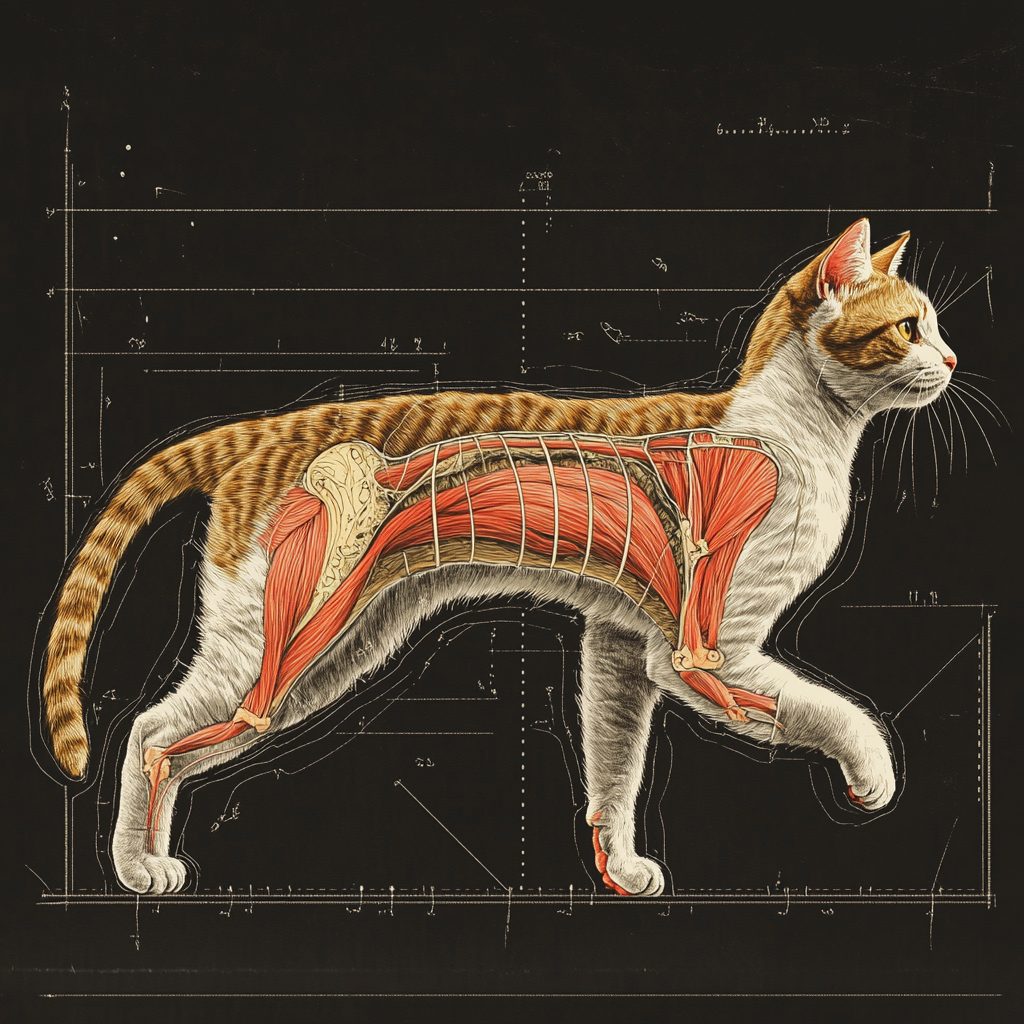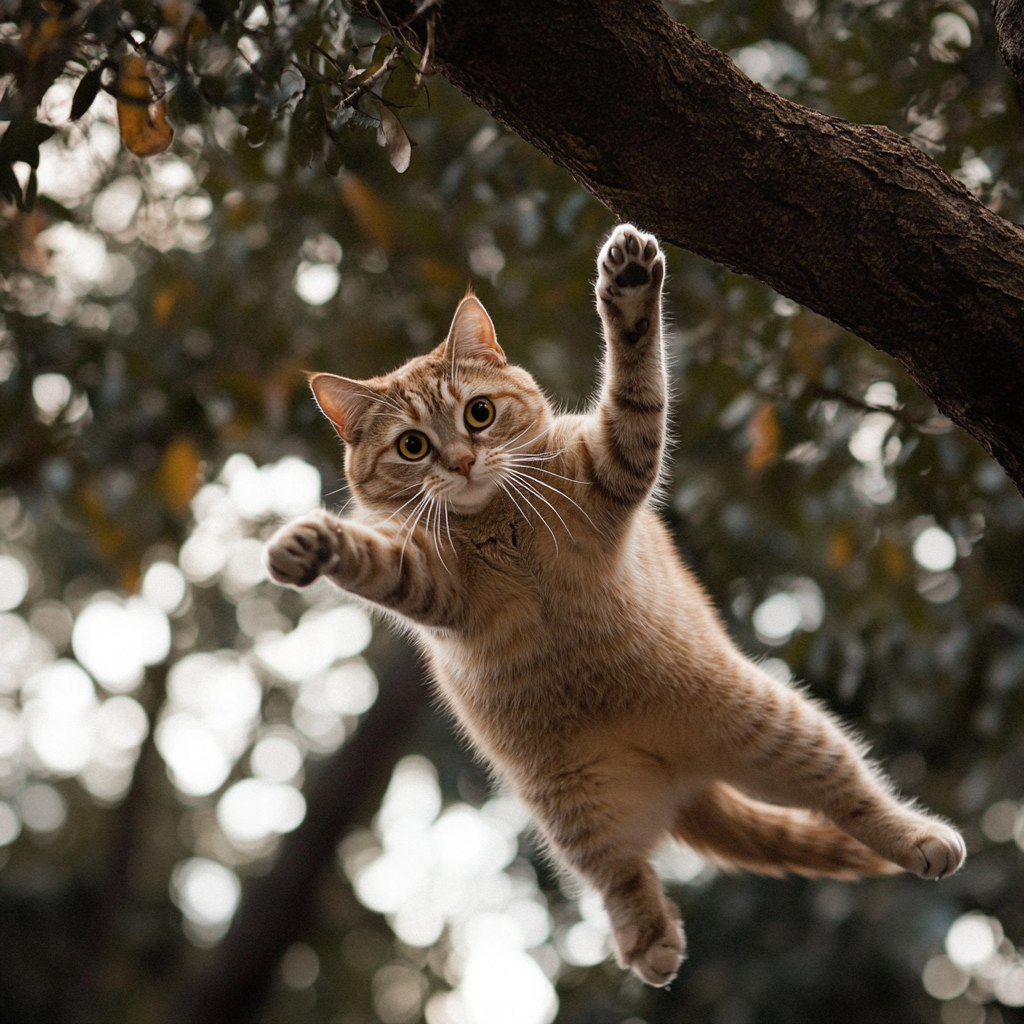Ever watched a cat fall and miraculously land on its feet? It’s not just luck – it’s a fascinating blend of feline physics and evolutionary prowess. Let’s dive into the gravity-defying world of the cat righting reflex and uncover why these furry acrobats seem to always stick the landing.
The Righting Reflex: A Feline Superpower
At the heart of a cat’s ability to land on its feet is the righting reflex. This innate ability begins to develop in kittens as young as 3-4 weeks old and is perfected by 6-9 weeks. It’s a complex neurological response that kicks into high gear the moment a cat senses it’s falling.
The secret sauce? A cat’s inner ear contains a vestibular apparatus – nature’s own gyroscope. This remarkable system detects changes in acceleration and position, instantly triggering a cascade of muscle movements that help the cat reorient itself mid-air.
Feline Flexibility: The Backbone of the Matter

Cats are the ultimate contortionists, thanks to their incredibly flexible backbone. With 30 vertebrae in their spine (compared to our measly 24), cats can bend and twist in ways that would make even the most accomplished yogi jealous. Add to this their lack of a functional collarbone, and you’ve got a recipe for mid-air acrobatics that would put Cirque du Soleil to shame.
This flexibility allows cats to perform a series of jaw-dropping maneuvers when falling:
- The “Bend and Twist”: Cats can twist their front and back halves in opposite directions, essentially creating two separate rotation axes.
- The “Tuck and Turn”: By extending and tucking their legs, cats can adjust their moment of inertia, much like a figure skater spinning on ice.
- The “Propeller Tail”: Some cats use their tails like a furry rudder, helping to steer their rotation.
The Physics of Feline Falls
Now, let’s geek out on some physics. The cat’s ability to land on its feet seems to defy the laws of conservation of angular momentum. This puzzling phenomenon has intrigued scientists for centuries, including the likes of James Clerk Maxwell.
Here’s the mind-bending part: cats can rotate their upper and lower body in opposite directions, effectively preserving their total angular momentum while still managing to flip over. It’s like watching a magician pull off an impossible trick, except the magician is your fluffy little Mittens, and the trick is defying gravity.
The High-Rise Syndrome Paradox

Here’s where things get really weird. You’d think that the higher a cat falls from, the worse off it would be, right? Wrong! Studies have shown that cats can actually survive falls from incredibly high floors – we’re talking up to 32 stories!
This mind-boggling fact is due to a combination of factors:
- Terminal Velocity: Cats reach a maximum falling speed of about 60 mph, after which they stop accelerating. This gives them time to relax and prepare for landing.
- Surface Area: By spreading out their legs, cats increase air resistance, slowing their fall even further.
- Shock Absorption: Those powerful, springy legs act like natural shock absorbers, cushioning the impact.
Interestingly, cats falling from lower heights (between 2-7 stories) often fare worse than those falling from greater heights. This is because they don’t have enough time to fully right themselves and relax their muscles before impact.
The Evolution of Aerial Prowess
So why did cats develop this gravity-defying superpower? It all comes down to their arboreal ancestry. Our feline friends evolved from tree-dwelling ancestors who needed to navigate high branches and make death-defying leaps to catch prey or escape predators.
This aerial acrobatics isn’t unique to domestic cats, either. Many wild cats, from nimble ocelots to powerful tigers, possess similar abilities. It’s a testament to the power of evolutionary adaptation – nature’s way of equipping these predators with the tools they need to survive and thrive in their environments.
The Limits of Feline Physics
Before you go tossing your cat off the balcony in the name of science (please don’t!), it’s crucial to understand that while cats are impressive aerial artists, they’re not invincible. Falls can still result in serious injuries, especially from extreme heights.
Factors that can impact a cat’s ability to stick the landing include:
- Age: Older cats may have slower reflexes or weaker muscles.
- Weight: Overweight cats might struggle to maneuver effectively in the air.
- Health: Pre-existing conditions can affect a cat’s agility and strength.
- Fall Distance: Cats need at least 2.5 feet of space to complete their righting reflex.
Keeping Your Feline Friends Safe

While it’s fascinating to marvel at our cats’ acrobatic abilities, it’s even more important to keep them safe. Here are some tips to protect your feline friend from potentially dangerous falls:
- Secure windows and balconies with sturdy screens.
- Keep furniture away from high places where cats might be tempted to explore.
- Provide plenty of safe climbing options, like cat trees and shelves, to satisfy their vertical instincts.
- Consider creating a “catio” – an enclosed outdoor space where your cat can safely enjoy fresh air and heights.
The next time you watch your cat effortlessly leap from a high perch or gracefully navigate a narrow ledge, take a moment to appreciate the incredible physics and biology at work. These feline acrobats are living, breathing examples of nature’s ingenuity, combining flexibility, instinct, and split-second calculations to perform feats that continue to amaze and inspire us.
So, while cats may not actually have nine lives, their remarkable ability to land on their feet certainly gives them a leg up in the survival department. It’s just one more reason to be in awe of our purr-fectly evolved feline companions.

